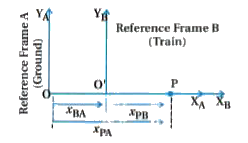Explain the relative velocity and its two cases. Solution in Gujrati
Case 1 Two observes and one moving object :

Let A be the frame of reference associated with person standing on the ground.
B is the frame of reference associated with the train moving with uniform velocity.
Both these reference frames are inertial frames of reference.
From the figure, xPA=xPB+xBA
Differentiating with respect to t,
dxPAdt=dxPBdt+dxBAdt
But dxPAdt=vPA,dxPBdt=vBA
∴v(PA)=vPB+vBA
∴vBA=vPA−v{PB)
Where vPA= Velocity of P with respect to reference frame A.
vPB= Velocity of P with respect ot reference frame B.
vBA= Velocity of reference frame B with respect to reference frame A.
Case 2 One observer and two moving objects :

Suppose particales A and B motion in reference of frame O- XY O - YZ in ground.
Suppose velocities of two particles A and B are respectively −→vAand−→vB releative to a farme of reference (suppose earth) then velocity vAGandvGB. Then velocity of B relative to A is,
vBA=vGA−vGB
=−vGB+vGB
∴vBA=−vBG−vAG
[∵vBG=−vGBandvGA=−vAG]
=vB−vA
and velocity of A relative to B is
vAB=vA−vB
=vAG−vBG
Topper's Solved these Questions
- MOTION IN A STRAIGHT LINE BOOK - KUMAR PRAKASHANCHAPTER - MOTION IN A STRAIGHT LINE EXERCISE - SECTION-A TRY YOUR SELF (VSQs)
52 Videos
- MOTION IN A STRAIGHT LINE BOOK - KUMAR PRAKASHANCHAPTER - MOTION IN A STRAIGHT LINE EXERCISE - SECTION-B
58 Videos
- MECHANICAL PROPERTIES OF FLUIDS BOOK - KUMAR PRAKASHANCHAPTER - MECHANICAL PROPERTIES OF FLUIDS EXERCISE - QUESTION PAPER (SECTION -C)
3 Videos
- OBJECTIVE QUESTIONS AS PER NEW PAPER STYLE BOOK - KUMAR PRAKASHANCHAPTER - OBJECTIVE QUESTIONS AS PER NEW PAPER STYLE EXERCISE - CHAPTER - 8 (Match Type questions)
5 Videos
Similar Questions
How can we determine whether the object is in rest or not?
View SolutionA car is moving along a straight line, say OP in It move from O to P in 18 s and returns from P to Q in 6s, where OP=360 m and OQ=240 m. What are the average velocity and average speed of the car in going (a) from O to P ? And (b) from O to P and back to Q ?
View SolutionGlycerine flows steadily through a horizontal tube of length 1.5m and radius 1.0 cm . If the amount of glycerine collected per second at one is 4.0×10−3kgs−1 , what is the pressure difference between the two ends of the tube ? (Density of glycerine =1.3×10103kgm−3 and viscosity of glycerine =0.83 Pa s). [ you may also like to check if the assumption of laminar flow in the tube is correct]
View SolutionType of satellites are given in Column-I and their uses are given in Column-II. Match them properly :
Column-IColumn-II(1) Polar satellite(a) Tele communication(2) Geo-stationary satellite(b) Investigation(c) For information about atmosphere
View SolutionRelative Angular Velocity In Case Of A Rigid Body
View SolutionStatement-1 : The relative velocity between any two bodies moving in opposite direction is equal to sum of the velocities of two bodies. Statement-2 : Sometimes relative velocity between two bodies is equal to difference in velocities of the two.
View SolutionGive an example of a case in which an object's velocity is zero but its acceleration is not. Can an object's velocity ever be in a direction other than the direction of its acceleration? Explain.
View SolutionShow that in the case of one dimensional elastic collision , the relative velocity of approach of two colloding bodies before collision is equal to the relative velocity of separation after collosion .
View SolutionIs zero relative velocity possible ? Explain ?
View Solutionएकविमीकय संघट्ट समझाइए। एकविमीय प्रत्यास्थ संघट्ट में सिद्ध कीजिए कि पिण्डों के पास अने का आपेक्षिक वेग- पिण्डों के दूर जाने का आपेक्षिक वेग।
अथवा
दो पिण्डों के एक विमीय प्रत्यास्थ संघट्ट के लिए सिद्ध कीजिए।
संघट्ट से पूर्व आपेक्षिक वेग =− (संघट्ट के बाद आपेक्षिक वेग)
View Solutionএকটি বস্তু বৃত্তাকার পথে ঘুরছে। কেন্দ্রের সাপেক্ষে তার কৌণিক বেগ, পরিধির কোনাে বিন্দুর সাপেক্ষে তার কৌণিক বেগের কত গুণ?
View SolutionExplain the concept of relative velocity in one and two dimensional motion.
View Solution(A):The relative velocity between any two bodies moving In opposite direction Is equal to sum of the velocities of two bodies.
(R ):Sometimes relative velocity between two bodies is equal to difference in velocities of the two bodies.
View SolutionRelative velocity in two dimensions
View SolutionShow that in case of one dimensional elastic collision of two bodies, the relative velocity' of sepa¬ ration after the collision is equal to the relative velocity of approach before the collision
View Solution